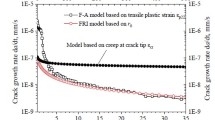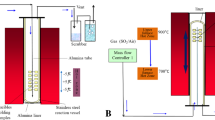Abstract
Due to their good corrosion resistance in high-temperature and wet corrosive environments, nickel-based alloys are widely used as construction materials in the chemical industry, as well as in offshore applications and other energy and environmental technologies. Their outstanding corrosion performance, however, is often accompanied by a limited weldability due to a high hot cracking sensitivity. This paper presents a comparative overview of the hot cracking susceptibility of iron and nickel-based alloys type 1.4958 (alloy 800 H), 2.4663 Q (alloy 617), 2.4816 (alloy 600 H), 2.4856 (alloy 625) and 2.4605 (alloy 59). Hot cracking tests are performed by PVR test (deformation crack test), using GTA-welded externally loaded specimens to rank the hot cracking sensitivity of the base metals. In order to gain further knowledge regarding formation and propagation of the hot cracks, optical microscopy and EDX-analyses were performed. In addition to a ranking of materials and processes, interim results regarding the crack types and the metallurgical causes of cracking are discussed.
Similar content being viewed by others
References
Herold H. and Zinke M.: Entwicklungstendenzen bei korrosionsbeständigen hochwarmfesten Werkstoffen und ihre schweißtechnische Verarbeitung, Trends of development for highly corrosion and heat resistant alloys and their weld-ability, Materialwissenschaft und Werkstofftechnik, 1999, vol. 30, no. 11, pp. 678–681 (in German).
Thomas R.D. Jr.: HAZ cracking in thick sections of austenitic stainless steels — Part II, Welding Journal,1984, vol. 63, no. 12, pp. 355s–368s.
Matting A. and Neitzel M.: Das Bewerten von Schweißfehlern im Dauerschwingversuch, Evaluation of weld defects in dynamic fatigue testing, Schweißen und Schneiden, 1996, vol. 18, no. 3, pp. 113–124 (in German).
Schuster J.: Heißrisse in Schweißverbindungen — Entstehung, Nachweis und Vermeidung, Hot cracking in welds — Formation, detection and prevention, Habilitation, Chemnitz, 2004 (in German).
Probst R., Beckert M. and Neumann A.: Grundlagen der Schweißtechnik — Schweißmetallurgie, Principles of welding —Welding metallurgy, Berlin, 1971 (in German).
Folkhard E.: Metallurgie der Schweißung nichtrostender Stähle, Welding metallurgy of stainless steels, Wien, 1984 (in German).
Thier H.: Deltaferrit und Heißrisse beim Schweißen chemisch beständiger austenitischer Stähle: Die Schweißtechnik im Dienste der Energieversorgung und des Chemieanlagenbaus, σ-ferrite and hot cracking during welding of chemical resistant austenitic steels, Düsseldorf, 1976, pp. 100–104 (in German).
Hemsworth B., Boniszewski T. and Eaton N.: Classification and definition of high temperature welding cracks in alloys, Metal Construction & British Welding Journal, 1969, no. 2(s), pp. 5-16.
Nissley N.E. and Lippold J.C.: Ductility-dip cracking susceptibility of Ni-based weld metals — Part 1, Welding Journal, 2008, vol. 87, no. 10, pp. 257s–264s.
Nissley N.E. and Lippold J.C.: Ductility-dip cracking susceptibility of Ni-based weld metals — Part 2, Welding Journal, 2009, vol. 88, no. 6, pp. 131 s–140s.
DuPont J.N., Lippold J.C. and Kiser S.D.: Welding metallurgy and weldability of nickel-base alloys, Hoboken, NJ 2009.
Lippold J.C., Baeslack W.A.I. and Varol I.: Heat-affected zone liquation cracking in austenitic and duplex stainless steels, Welding Journal, 1992, vol. 71, no. 1, pp. 1s–14s.
Schuster J.: Grundlegende Betrachtung zur Entstehung von Heißrissen, Basic considerations on the formation of hot cracks, Schweißen und Schneiden, 1998, vol. 50, no. 10, pp. 646–654 (in German).
Nissley N.E. and Lippold J.C.: Development of the strain-to-fracture test for evaluating ductility-dip cracking in austenitic alloys, Welding Journal, 2003, vol. 82, no. 12, pp. 355s–364s.
Krafka H.: Risse in Schweißverbindungen: Heißrissarten, Heißrissentstehung und Heißrissprüfung, Weld cracking: types, formation and testing of hot cracking. Richard, H. A. (eds.): Festigkeits- und Bruchverhalten von Fügeverbindungen, Berlin 2000, pp. 161–171 (in German).
Ramirez A.J. and Lippold J.C.: New insight into the mechanism of ductility dip cracking in Ni-base weld metals. Böllinghaus T., Herold H. (eds.): Hot cracking phenomena in welds, Berlin, 2005, pp. 19–41.
Kikel J.M., Parker D.M., Vitek J., David S., Johnson J., Smartt H. and DebRoy T.: Ductility dip cracking susceptibility of filler metal 52 and alloy 690, ASM Proceedings of the International Conference: Trends in Welding Research, 1998, pp. 757–762.
Lippold J.: Recent developments in weldability testing for advanced materials, Lienert T.J. (eds.), Joining of advanced and specialty materials VII, Materials Park OH, 2005, pp. 1-7.
Prokhorov N.N.: The technological strength of metals while crystallising during welding, IIW Doc. IX-479-65, 1965.
Folkhard E., Rabensteiner G.S.H., Fuchs K. and Tösch L.: Der PVR-Test, ein neues Verfahren zur Ermittlung der Heißrisssicherheit von Schweißwerkstoffen mit hoher quantitativer Aussagekraft: 50 Jahre Böhler Schweißtechnik. Jubiläumsband, The PVR test, a highly significant, quantitative test method for determining the hot cracking resistance of weld metals. Wien, 1977 (in German).
Farrar J.C.M.: Hot cracking tests — The route to International Standardization? Böllinghaus T.; Herold H. (eds.), Hot cracking phenomena in welds, Berlin, 2005, pp. 291–304.
Keil D., Zinke M. and Pries H.: Investigations on hot cracking of novel high manganese TWIP-steels, Lippold J.C., Böllinghaus T., Cross C.E. (eds.), Hot cracking phenomena in welds III, Berlin, 2011, pp. 209–224.
Schulze G.: Die Metallurgie des Schweißens-Eisenwerkstoffe — nichteisenmetallische Werkstoffe, Welding metallurgy — Ferrous — nonferrous metals, 4. Aufl., Berlin, 2010 (in German).
Collins M.G., Ramirez A. and Lippold J.C.: An investigation of ductility-dip cracking in Ni-base filler metals — Part 2, Welding Journal, 2003, vol. 82, no. 12, pp. 348s–354s.
Ramirez A.J. and Lippold J.C.: High temperature cracking in nickel-base weld metal: Part 1 — Ductility and microstructural characterization, Materials Science and Engineering A, 2004, vol. 380, no. 1-2, pp. 259–271.
Author information
Authors and Affiliations
Corresponding author
Additional information
Institute of Materials and Joining Technology, Otto von Guericke University of Magdeburg
Rights and permissions
About this article
Cite this article
Fink, C., Zinke, M. & Keil, D. Evaluation of Hot Cracking Susceptibility of Nickel- Based Alloys by The Pvr Test. Weld World 56, 37–43 (2012). https://doi.org/10.1007/BF03321363
Published:
Issue Date:
DOI: https://doi.org/10.1007/BF03321363




